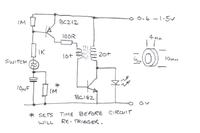neazoi
Advanced Member level 6

- Joined
- Jan 5, 2008
- Messages
- 4,157
- Helped
- 13
- Reputation
- 26
- Reaction score
- 15
- Trophy points
- 1,318
- Location
- Greece
- Activity points
- 37,198
It should flash the LED for no more than about 1 second then it should go off completely and the circuit then draws no current. I suspect what is happening is the voltage in the transformer secondary (base side) is too high and it is enough for the transistor to maintain oscillation by itself when the bias is removed. Try removing turns from the secondary winding and see if that fixes it. Maybe the difference in the core I used is responsible for the extra feedback you are seeing. If all is well, if you short the emitter and collector of the PNP transistor, the LED should stay lit and it should go out as soon as you remove the short.
Brian.
No, I think you got it the other way round. What I mean is this:
With the original schematic, When I vibrate it (an only when I do so, not at other times) the LED flashes. But the joule thief is not blocked after a few vibrations, as it should.
It is blocked at all times when no vibration. But it is not deactivated after a few vibrations as it should.
As I see it this is a sign that the 10uF never charges.
I have tried it with a single 10nF instead and no discharge 1M resistor at all and it worked ok. After a few vibrations the oscillator is blocked. Of course there war no discharging resistor then and I had to short circuit the cap leads to discharge it manually.
But it does not work with the 10uF in place.
Any ideas?



